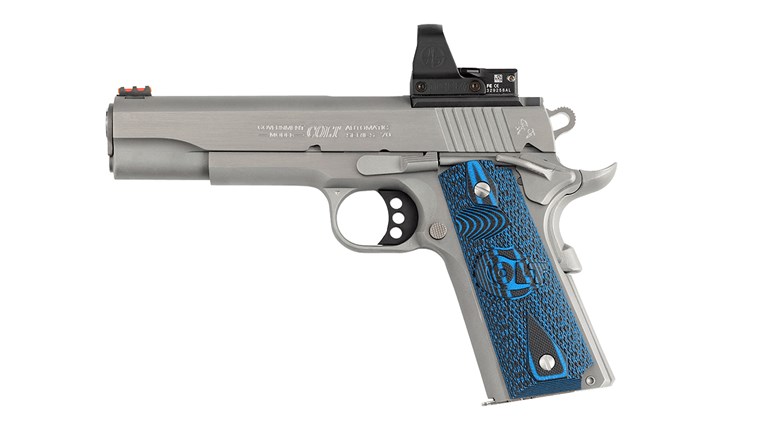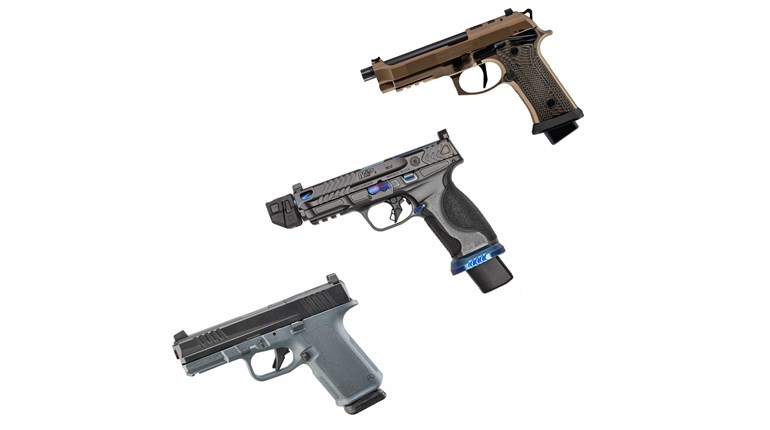
Jeff Cooper and I sat down in front of the fireplace warming the Sconce at Gunsite, he in his favorite chair and I on the couch facing the fire. We both took the pistols out of our holsters and set them on the end tables before sitting, a habit appreciated by the gracious Janelle Cooper because she didn't like her furniture torn or scratched. Mine was a full-size 1911, and Jeff's was a Commander, his favorite carry pistol for 20 years or more. As we discussed a couple of subcompact 1911s being used in class that were not running reliably, the conversation moved from reliability to portability and the overall "shootability" of various 1911 pistols. Jeff soon pronounced the Commander-size 1911 "just about right" in all respects.
Years later, Ruger introduced its full-size SR1911 in .45 ACP. A stainless steel, full-feature pistol at a reasonable price, the SR1911 has remained in high demand since the company released it in 2011. Production of the pistol has almost tripled in Ruger's Prescott, AZ, factory during the past two years. Now, in a move Jeff Cooper would surely approve, Ruger offers a Commander-style SR1911.
Given Ruger can sell every SR1911 it makes, you might wonder why the company would come out with a new model. There are a couple of reasons. First, Ruger intended the full-size SR1911 to be the start of a 1911 pistol line, not a stand-alone product. Second, Ruger's success in recent years is based, in part, on a continuous flow of new products to consumers. The company tests its product concepts through a program called "Voice of the Customer," and one of the products customers wanted was a Commander-size SR1911.
A Commander-type 1911 is simply a slightly shortened version of the original with a 4.25-inch barrel and matching slide instead of the typical 5-inch barrel and attendant slide. You wouldn't think shortening the barrel by three-quarters of an inch would make much of a difference, but in the case of the Commander, the result is dramatic. The pistol looks better, is better balanced, points quicker, is easier to conceal and carry and shoots as well as a full-size 1911.
The 1911 platform has evolved since John Moses Browning designed the pistol more than 100 years ago. Mistakes have been made, secrets discovered and truths learned. Ruger wisely took advantage of this accumulated wisdom by consulting with engineers and gunsmiths who really know the 1911 platform when designing the SR1911. Most notably, the company sought the advice of Wayne Novak, who knows as much about 1911s as anyone and has forgotten more than most. Ruger applied the same design and features to the Commander-style model as the full-size SR1911, so what you have is an abbreviated, but otherwise identical, pistol.
Ruger is rightly proud of the Commander-style SR1911 being 100-percent American made. The stainless steel frame and slide are precisely CNC-machined at the company's modern factory in Prescott. Cut from the same piece of steel, the barrel and barrel bushing are machined together as a set. The result is a match-quality fit the gunsmiths of days gone by could only dream of having achieved by hand-fitting, at a fraction of the price.

The Commander-style SR1911 uses a Series 70 fire-control system, referring to the Colt Series 70 pistol introduced in, well, 1970. Allow me to digress, because a little history is in order. For product-liability reasons, Colt later replaced the Series 70 with the Series 80, which included a trigger-actuated firing-pin safety. Lawyers told Colt the firing-pin safety was necessary in case a loaded pistol was dropped onto concrete, precisely on the muzzle from a height of 5 feet, perhaps allowing it to fire because the spring-loaded, rebounding firing pin might bounce forward and strike the primer of a chambered round. Regardless of the potential safety benefit, fans of the 1911 disliked the Series 80 design because they said it changed the feel of the trigger.
One of the things we've learned over the years is a lightweight firing pin with a strong firing-pin spring will not rebound and accidently fire the pistol. A firing-pin safety is unnecessary in this type of setup. This brings us back to Ruger's SR1911 design, which has a lightweight titanium firing pin and a heavy-duty firing-pin spring. The pistol will not fire until the shooter fully depresses the grip safety by firmly gripping the pistol in the hand, deactivates the thumb safety by pushing it down and presses the trigger to the rear.
Ruger tests the triggers of SR1911 pistols on a fixture connected to a computer in the final assembly area of the production line. The process produces a graphical representation of the trigger's smoothness and pull weight at the point of release, as well as shows whether the trigger functions consistently. The standard for pull weight is between 4 and 5 pounds. According to my Lyman electronic trigger-pull gauge, the trigger on my sample pistol broke at 4 pounds, 14 ounces when new. There was a tiny bit of creep—trigger movement after take-up—but no over-travel, or trigger movement after sear release, and the trigger broke very crisply. After considerable dry-firing and shooting, the trigger settled in and now breaks at 4 pounds, 11 ounces. The small amount of creep has disappeared.
The Commander-style SR1911 has a three-hole, lightweight aluminum trigger, a lightweight hammer and angled slide-cocking serrations located where they should be—on the rear of the slide. Along with the beavertail-type extended grip safety, the slide stop, extended thumb safety, extended magazine release and checkered mainspring housing are all finished in black. These components contrast nicely with the satin-stainless finish of the rest of the pistol. The traditionally checkered, double-diamond wooden grips inset with silver Ruger logos are the nicest I have seen on a production pistol.
Another feature the Commander-style SR1911 shares with its predecessor is the absence of a staked-on plunger tube on the left side of the frame. The plunger tube is still there, but it's an integral part of the frame. Plunger tubes that come loose or fall off have plagued 1911 pistols for generations, but Ruger has eliminated this problem.
Since Ruger consulted with Novak when designing the pistol, it's no surprise the sights are seated in Novak-spec dovetails. The rear sight is the excellent Novak LoMount with two white dots, while the front sight has a single white dot. Ruger's marketing people tell me consumers want three-dot sights, so the company chose to install them on the Commander-style SR1911. On the other hand, if you like plain black sights, night sights or almost any other combination, you can change them. Sending the slide to Novak's and telling the company what you want is one easy way to switch the sights. My preferred combination is the plain, black rear LoMount and gold-bead front sight.
The pistol ships with two, seven-round, stainless steel magazines. If you would like to use genuine Ruger eight-round magazines in your Commander-style SR1911, the company sells them with removable, extended base plates at shopruger.com.
Steel-frame, Commander-size 1911 pistols weigh about the same as full-size models, minus 4 ounces or so. When fully loaded with eight rounds of ball ammunition, my sample Commander-style SR1911 weighs 43 ounces. The overall feel during firing and recoil of the test pistol was about the same as a full-size 1911. I could hardly notice any difference.

I shot the Commander-style SR1911 over several range sessions and, whether firing fast pairs at closer ranges or shooting for precision at 25 and 50 yards, found the sights to be dead on. Stretching the range even farther, I concluded my testing by shooting at 100 yards on a steel silhouette target using Black Hills 230-grain full-metal-jacket ammunition. From a solid, braced kneeling position with the head of the target perched atop the front sight, I was rewarded with more hits than misses despite the presence of a strong crosswind. The Commander shoots better than I do, which is apparent from some of the erratic group sizes I fired during formal accuracy testing.
Working with a pistol from the holster for a couple of days will reveal if there are sharp edges that are going to cause sore spots or cuts on your hands. If you shoot a 1911 the way it is supposed to be shot—with the thumb on top of the thumb safety— you will quickly discover whether the rear of the thumb safety and the grip safety have been properly fitted and "dehorned." Any sharp edges that have not been smoothed and removed will soon become apparent. I have a nice collection of scars between the thumb and first finger of my shooting hand because I have been sliced and gouged in the soft web area many times by pistols with sharp points and edges. Since I'm tired of bleeding on pistols, it's my pleasure to report the Commander-style 1911 did not give me any new scars.
There are a couple of places I would smooth with a light stoning. The edges of the ejection port are pretty sharp, causing the front edge to gouge little chunks from leather holsters when drawing the pistol. I would also knock some of the sharp edges off the hammer because I have tender thumbs. These small nitpicks don't affect shooting or handling and, because the pistol is stainless steel, some careful stoning won't harm the finish.
Despite prognostication to the contrary, the 1911 pistol has not been replaced by modern polymer-frame handguns. There are several reasons for this. Far and away, 1911 pistols have the best triggers. The trigger of a good 1911 "snaps;" it doesn't "sproing" like those of polymer pistols. Once shooters experience it, they often decide in favor of the better trigger. On top of that, 1911s are powerful, reliable, easy to shoot well and can be customized to the shooter's preferences from the almost unlimited parts and accessories available.
The Ruger Commander-style SR1911 is far from a basic pistol, but it's not an expensive custom piece, either. To my mind it represents good value—it has everything you need and nothing you don't. I like it the way it is. Still, if you want to change sights, add additional checkering, switch grips or make any other modifications, the Commander-style SR1911 is a good place to start. What's next in the Ruger SR1911 line? I really don't know, but I'm thinking an alloy-frame, lightweight model would be the logical next step. In the meantime, I expect the Commander-style SR1911 to do very well. It's just about right.
Specifications
Manufacturer: Ruger; (928) 541-8820, ruger.com
Action Type: Recoil-operated, semi-automatic
Caliber: .45 ACP
Capacity: 7+1 rounds
Slide: CNC-machined, stainless steel bar stock
Frame: CNC-machined, investment-cast stainless steel
Barrel Length: 4.25 inches
Rifling: 6 grooves; 1:16-inch RH twist
Sights: Novak three-dot
Trigger Pull Weight: 4 pounds, 11 ounces
Grips: Checkered hardwood with Ruger medallion
Length: 7.92 inches
Height: 5.45 inches
Width: 1.34 inches
Weight: 34.2 ounces
Accessories: Two magazines, barrel-bushing wrench, manual, padlock, soft case
MSRP: $829
Shooting Results
| Load | Velocity | Group Size | ||
| Smallest | Largest | Average | ||
| Cor-Bon +P 185-grain DPX | 958 | 3.50 | 5.00 | 4.10 |
| Remington Express 185-grain Metal Case WC Match | 779 | 2.00 | 2.50 | 2.20 |
| Black Hills 230-grain FMJ | 783 | 3.50 | 4.50 | 4.00 |
| Winchester 230-grain FMJ Match (military) | 799 | 2.00 | 4.50 | 3.45 |
Velocity measured in fps 10 feet from the muzzle for 10 consecutive shots using a Shooting Chrony chronograph. Temperature: 40 degrees Fahrenheit. Accuracy measured in inches for five consecutive, five-shot groups from a sandbag rest at 25 yards.






































